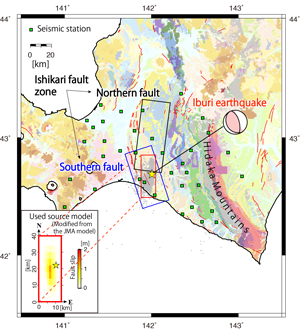地震の研究のためにはまず,実際にどこでどのような地震が発生しているかを知る必要があります.
そして,その理解のためには,地震発生の背景となる物理的・化学的要因が何であるかを検討しなければなりません.
そこで,地震波形データ,地震カタログデータ,測地データを解析して,震源における断層すべり過程,その簡易版としての震源スペクト
ル,震源メカニズム解(代表的な断層面と断層すべりの方向),地震発生の統計的性質,地震発生深度における歪や応力の蓄積を推定して
います.これらの研究成果を総合的に検討して,地震発生の物理的背景を明らかにしていきます.物理的背景のさらに裏側には,地質学
的・地球化学的な要因が潜んでいると考えています.必要に応じて,臨時地震観測も実施しております.
現在は,震源メカニズム解の情報による地殻応力分布をとりまとめております.地震波形データ解析の大量処理のために深層学習技術の応
用も進めています.
For earthquake studies, we need know where and how earthquakes
occur. To understand earthquake generation mechanisms, we
should consider the physical and chemical factors for it. We
study the fault rupture process, the earthquake source
spectra, the focal mechanisms (the orientation of a
representative fault plane and the direction of a fault slip),
the statistical feature of earthquakes, and the accumulation
of the strain and stress at seismogenic depths using
seismograms, earthquake catalogs, and geodetic
data.Integrating these information, we will reveal the
physical background of the earthquake generation process. The
physical background will imply the geolocagil and geochemical
factors. If necessary, we perform a campaign seismic
observation.
Recently, we are investigating the crustal stress field in
Japan by estimating earthquake focal mechanisms and compling
them. We are introducing the deep learning technique for
processing massive seismic data.
これまで地震の発生時期・規模の予測は断層の活動履歴調査に基づいて経験的に行われ,各断層で想定される地震はそれぞれ独立に評価
されてきました.しかしながら実際には近くの地震は互いに影響し合い,例えば海溝型地震の発生サイクルは内陸地震の発生分布に影響を
及ぼしていることが指摘されています.また近年の観測網の発達によって,断層面上のすべりの時空間的な不均質が明らかになってきてお
り,地震の発生予測にはこれら異なるすべり現象間の相互作用が果たす役割を明らかにすることが重要です.
そこで有効な手立となりうるのが,計算機の中で,物理モデルに基づいて断層への応力蓄積過程・地震時のすべりの繰り返しつまり地震サ
イクルを模擬する,地震サイクルシミュレーションです.地震テクトニクス研究グループでは現在,海溝型地震と内陸地震間の相互作用を
考える際に重要となる,粘弾性応力緩和の効果を考慮した地震サイクルモデルの計算手法開発を行なっています.以下では,これに関連す
る研究成果を紹介します.
The timing and the magnitude of a future earthquake on an
active fault have been empirically estimated, independently
from earthquakes on the other faults, based on the rupture
histories of the fault. However, they should interact with
each other, and it is pointed out that the cycle of megathrust
earthquakes in subduction zones more or less control the
spatiotemporal distribution of inland earthquakes. Moreover,
recent improvement of the seismic/geodetic observation
networks has been revealed the various slip patterns and types
on a fault. We think the mechanical interaction of the
multiple slip events plays an important role in the occurrence
of an earthquake, and we are trying to understand the results
of their interactions using numerical simulations.
In the simulations called earthquake cycle simulations (ECSs),
we evaluate the stress build-up and the strength on a fault
and simulate the development of slip on the fault through the
earthquake cycle. We are now developing a technique to
consider the stress relaxation of the viscoelastic medium in
the ECS, which is important when we consider the relation of
megathrust earthquakes in subduction zones and inland
earthquakes. We introduce some of our work related to this
project.
2018年に発生した北海道胆振東部地震の近くには,主要活断層の一つである石狩低地東縁断層帯があります(図1).本研究では胆
振地地震後この断層帯が動きやすい状態になっているかをクーロン応力(ΔCFF)を用いて評価しました.
ΔCFFはイベントによって断層にかかる応力変化から計算され,ΔCFFが正のとき,断層の状態はイベント前よりも地震に近づいたと
考えられます.ΔCFFは通常媒質を均質弾性体と仮定して求められますが,本研究では地下の粘弾性媒質領域での応力緩和を考慮し,胆
振地震によるΔCFFの時間変化を求めました(図2:
石狩断層帯のうち南部断層).断層面上で場所によってΔCFFの正負が変化し,地震時も地震後20年間でもずっとΔCFFが増加し続ける地点があることが
わかりました.詳細はOhtani and Imanishi (2019, EPS;
https://doi.org/10.1186/s40623-019-1036-4)をご覧ください.
2018 Hokkaido Eastern Iburi earthquake occurred in the
vicinity of the fault zone in the eastern boundary of Ishikari
low-land (Ishikari faults) (Fig 1). We assessed the potential
of seismic risk of the Ishikari faults by the Coulomb failure
function (ΔCFF). ΔCFF is calculated from the stress change due
to an event; positive ΔCFF indicates that the target fault is
brought closer to rupture. In this study, we took into account
the stress relaxation in the viscoelastic medium and
calculated the time-dependent ΔCFF after the Iburi earthquake
(Fig 2; Southern fault in the Ishikari fault zone). We found
that ΔCFF distributes on the fault with the values from
positive to negative and the ΔCFF at some points keep
increasing for 20 years after the Iburi earthquake. Please see
detail in Ohtani and Imanishi (2019, EPS;
https://doi.org/10.1186/s40623-019-1036-4)

石狩低地東縁断層帯,北海道胆振地震と用いた震源モデル
Ishikari faults, Iburi earthquake and the source model
employed in this study.

t = 0に発生した胆振地震後,石狩低地東縁断層帯のうち南部断層上でのΔCFF(t). 左:
南部断層上のΔCFF(t)−ΔCFF(0)分布(地震後10年間の粘弾性緩和による変化量) 右:
南部断層上の各3点での,胆振地震直後から20年間のΔCFF変化.
Time-dependent ΔCFF(t) along the southern fault after the
occurrence of the Iburi earthquake (t = 0). Left:
Distribution of ΔCFF(t)−ΔCFF(0) along the southern fault.
Right: Time evolution of ΔCFF for 20 years after the Iburi
earthquake at the three points on the southern fault.
内陸大地震の震源の多くは地下 10-15 km の地震発生層の下限付近に位置します.地震発生の背景となる物理・化学的要因を知るためには,震源付近の岩石変形過程を明らかにする必要があります.しか し現在の活断層深部を直接観察し,詳細な変形過程を明らかにすることは困難です.一方,過去の地下 10-15 km付近における断層運動の痕跡が,地殻変動等により地表に露出している場所があり,削剥断層と呼ばれています.削剥断層の地質調査により,詳細な岩石の 変形過程と,その空間的広がりを明らかにしています.
The hypocentres of inland large earthquakes generally occur in the depths ranging 10–15 km, the deepest part of the seismogenic zone. To reveal physical and chemical processes that control the generation of earthquakes, it is important to know the detailed rock deformation processes around the hypocenter regions. However, it is impossible to observe directly the rock deformation in the deep part of the active faults. On the other hand, rocks along some faults were initially deformed in the depths of 10–15 km were eventually exhumed to the Earth’s surface, known as exhumed faults. We investigate such exhumed fault zones and reveal the deformation processes together with the fault zone architectures.
ドローン (UAV) で撮影した中央構造線の露頭の動画.
黒っぽい岩石(三波川変成岩)と淡白色もしくは黄土色の岩石(領家花崗岩類)の境界が中央構造線です.
Video of an outcrop of the Median Tectonic Line (MTL: the
largest onshore fault in Japan) taken by an unmanned aerial
vehicle (UAV).
The boundary between black coloured rocks (the Sambagawa
metamorphic rocks) and ochreous or pale coloured rocks (the
Ryoke granitoids) is the MTL.